Peaking amplifier frequency tuning
Chen , et al. Feb
U.S. patent number 10,211,790 [Application Number 15/790,144] was granted by the patent office on 2019-02-19 for peaking amplifier frequency tuning. This patent grant is currently assigned to GLOBALFOUNDRIES INC.. The grantee listed for this patent is GLOBALFOUNDRIES Inc.. Invention is credited to Michael Chen, Mohak Chhabra, Steven M. Clements, Hayden C. Cranford, Jr., Steven E. Mikes.

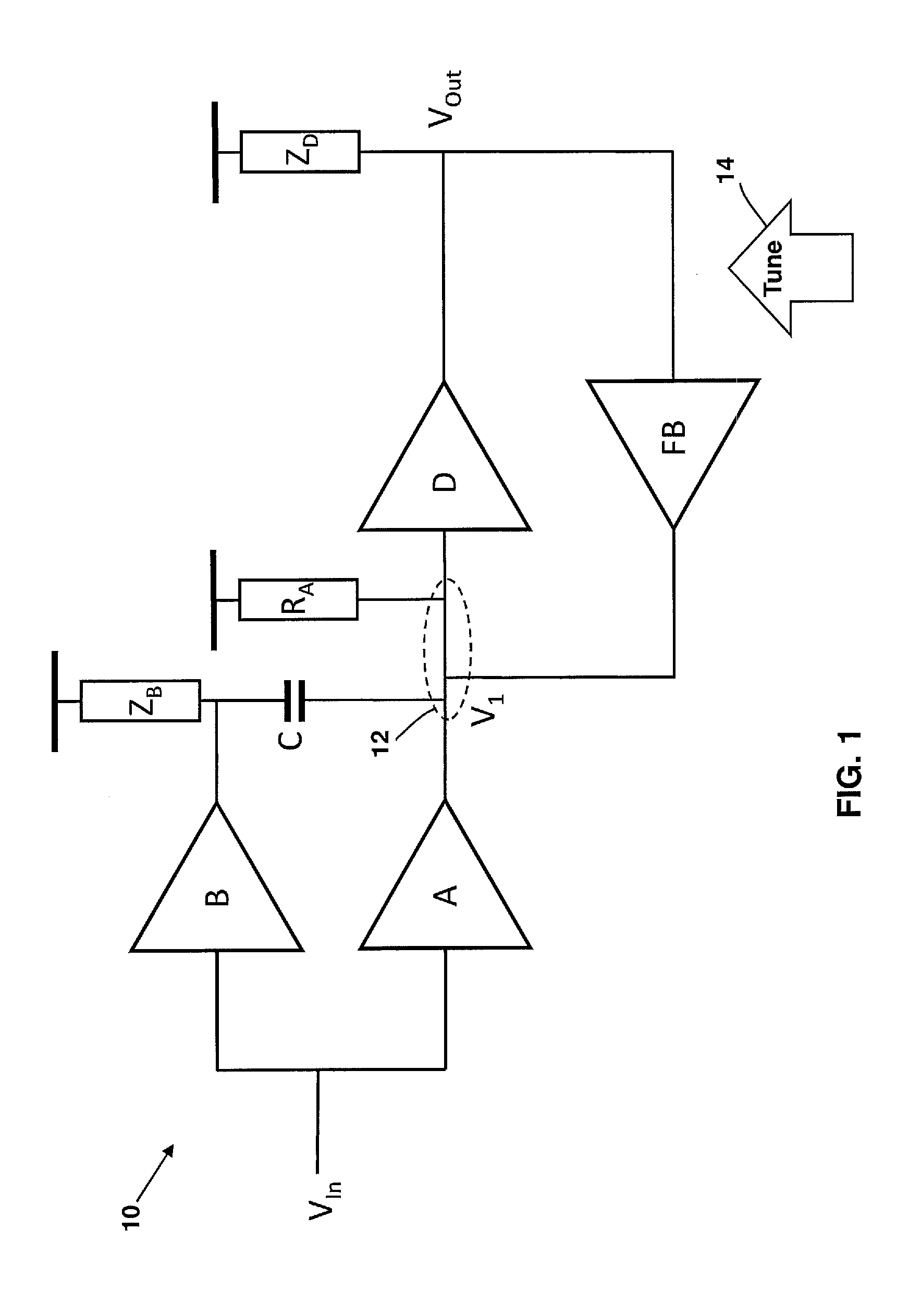
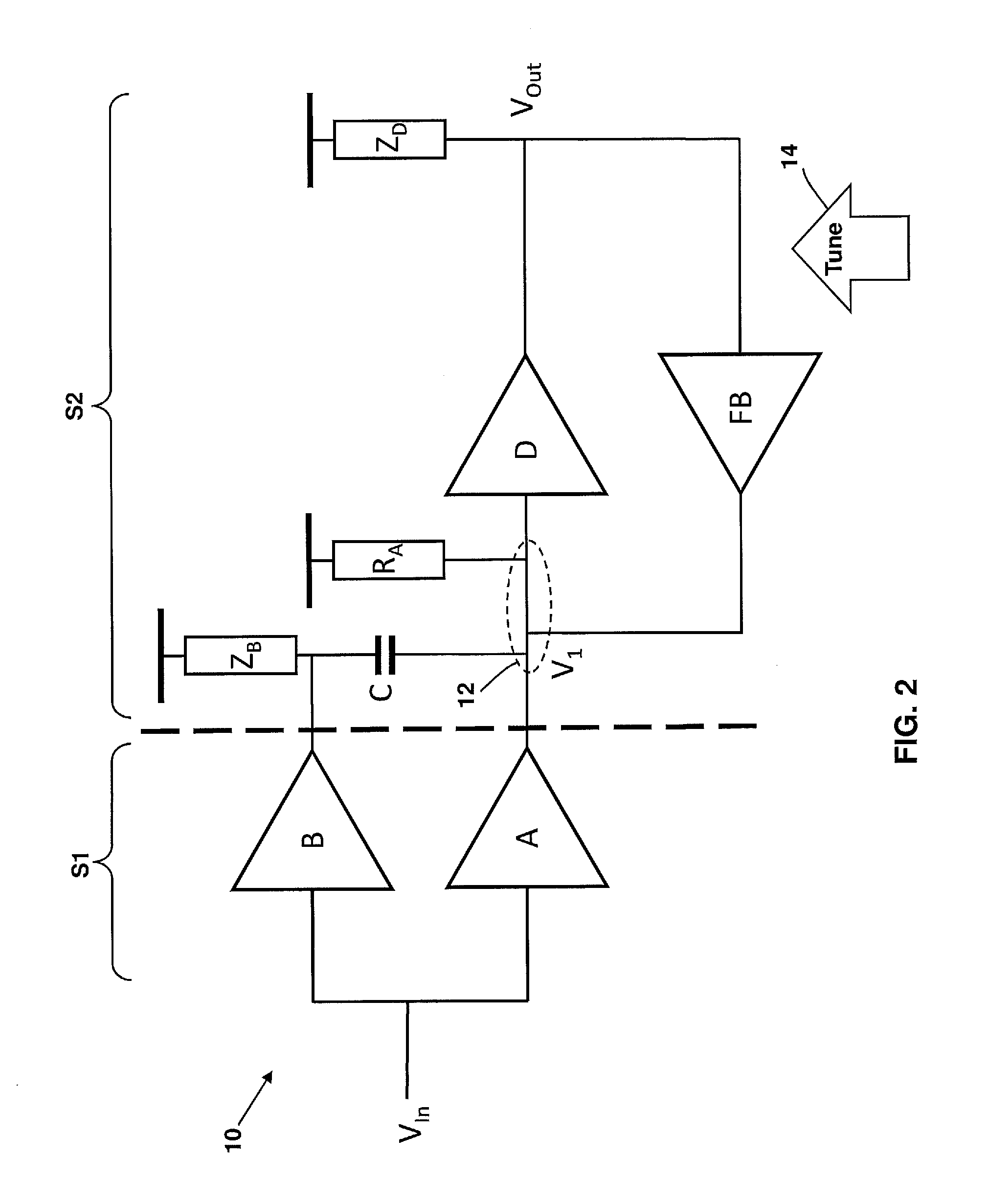



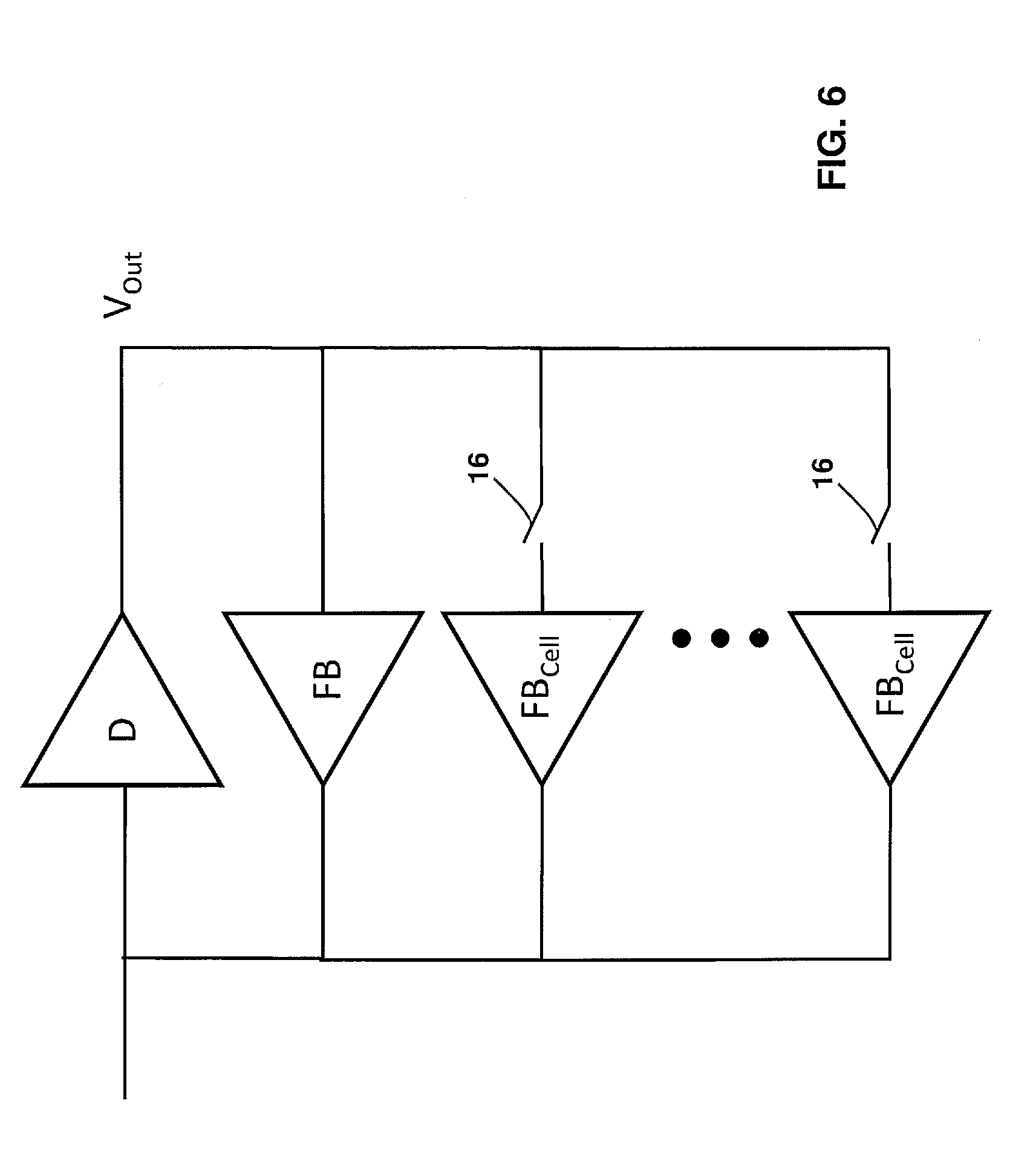
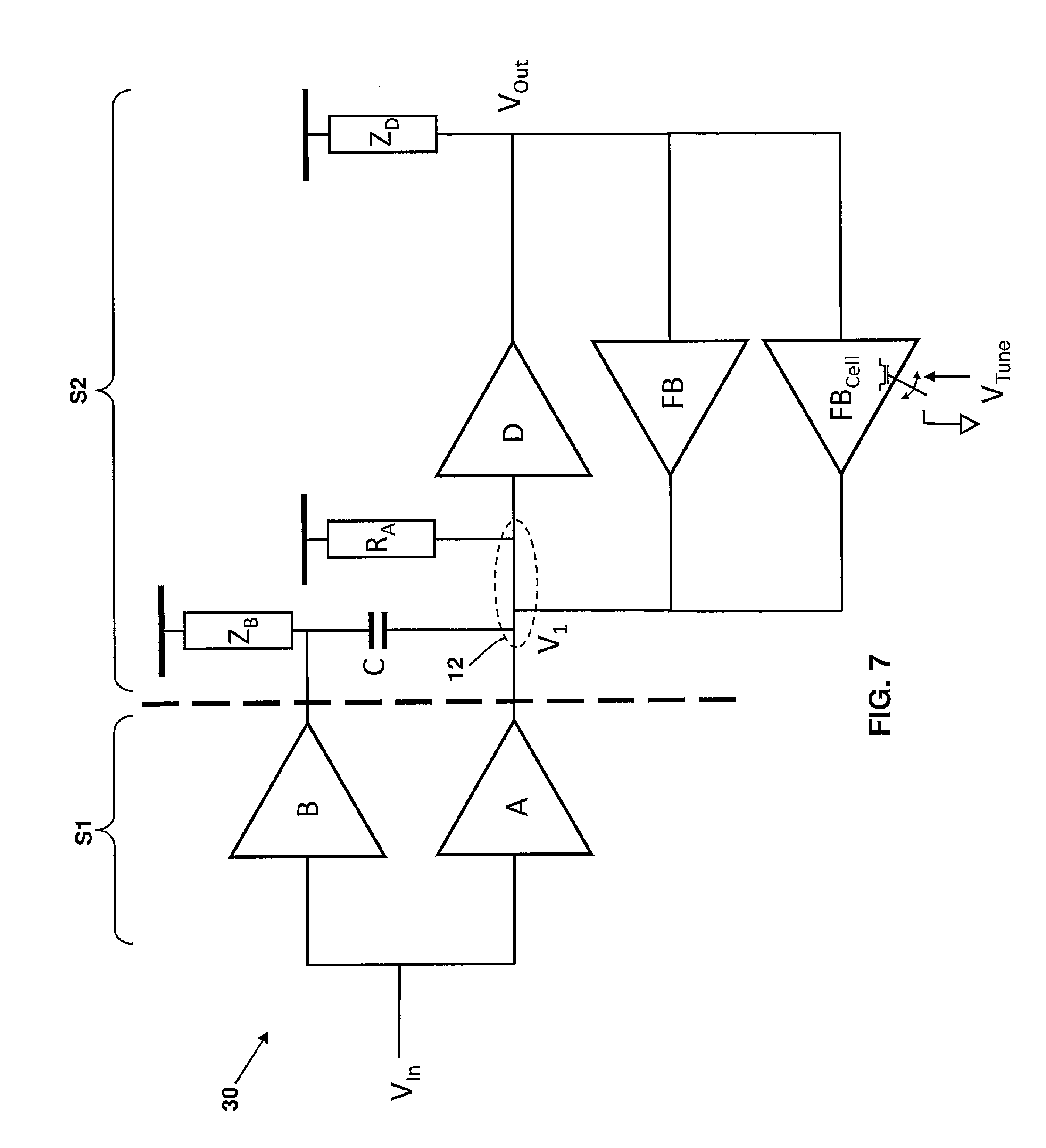


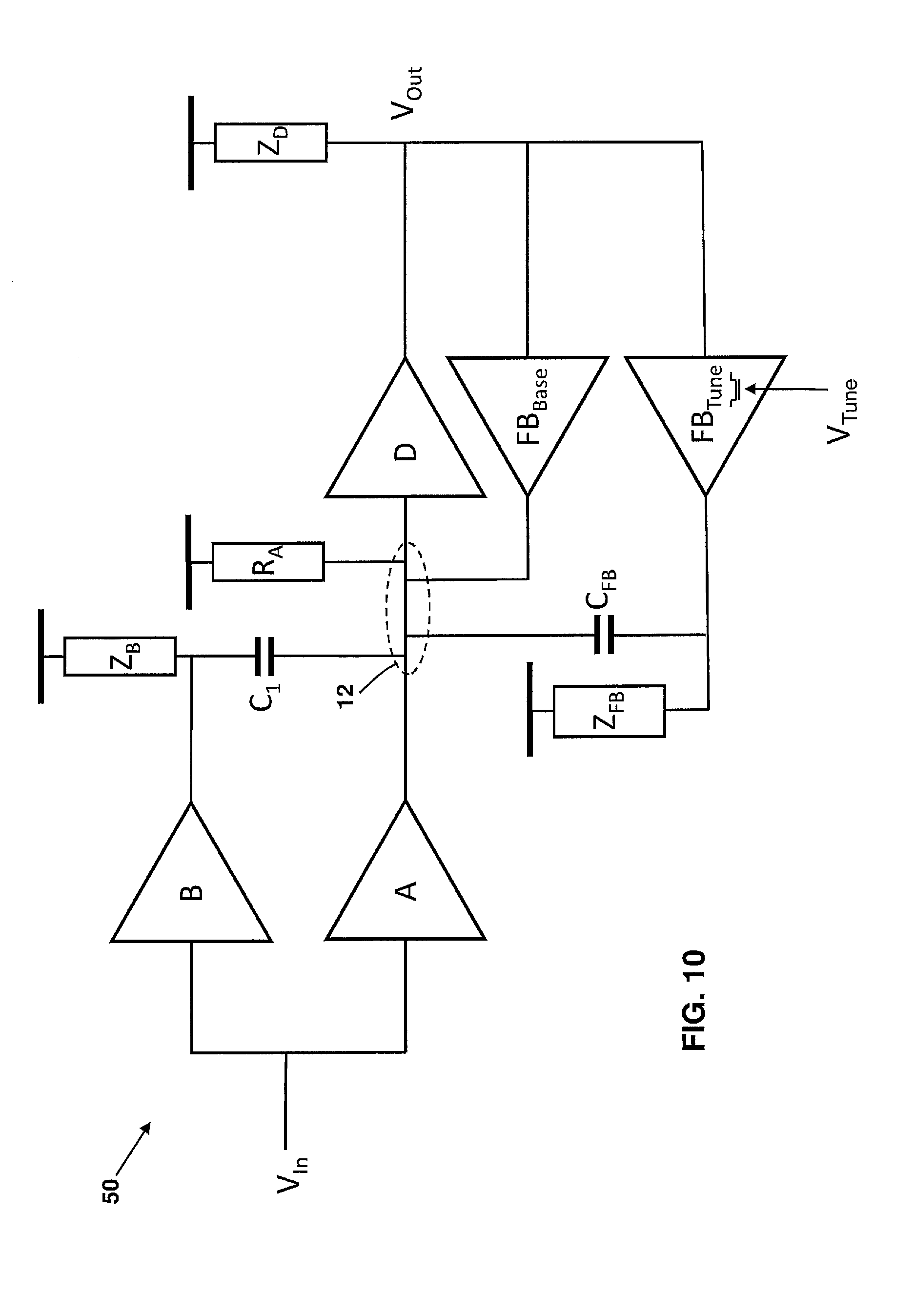

View All Diagrams
| United States Patent | 10,211,790 |
| Chen , et al. | February 19, 2019 |
Peaking amplifier frequency tuning
Abstract
A circuit including: input and output nodes and first and second feedback nodes; a first input amplifier having an input connected to the input node and an output connected to the first feedback node; a second input amplifier having an input connected to the input node and an output connected to the second feedback node; a capacitor connecting the first feedback node and the second feedback node; an amplifier having an input connected to the first feedback node and an output connected to the output node; a base feedback amplifier with an input connected to the output node and an output connected to the first feedback node; a tunable feedback amplifier with an input connected to the output node and an output connected to the second feedback node; and a tuning circuit for varying a transconductance of the tunable feedback circuit and operational frequency of the peaking amplifier circuit.
| Inventors: | Chen; Michael (Raleigh, NC), Clements; Steven M. (Raleigh, NC), Chhabra; Mohak (Cary, NC), Mikes; Steven E. (Apex, NC), Cranford, Jr.; Hayden C. (Cary, NC) | ||||||||||
|---|---|---|---|---|---|---|---|---|---|---|---|
| Applicant: |
|
||||||||||
| Assignee: | GLOBALFOUNDRIES INC. (Grand
Cayman, KY) |
||||||||||
| Family ID: | 60674723 | ||||||||||
| Appl. No.: | 15/790,144 | ||||||||||
| Filed: | October 23, 2017 |
Prior Publication Data
| Document Identifier | Publication Date | |
|---|---|---|
| US 20180278218 A1 | Sep 27, 2018 | |
Related U.S. Patent Documents
| Application Number | Filing Date | Patent Number | Issue Date | ||
|---|---|---|---|---|---|
| 15467589 | Mar 23, 2017 | 9853612 | |||
| Current U.S. Class: | 1/1 |
| Current CPC Class: | H03F 3/211 (20130101); H03F 1/34 (20130101); H03F 1/486 (20130101); H03F 3/191 (20130101); H03F 3/68 (20130101); H03F 3/195 (20130101); H03F 2200/135 (20130101) |
| Current International Class: | H03F 1/06 (20060101); H03F 1/48 (20060101); H03F 3/68 (20060101); H03F 3/191 (20060101) |
| Field of Search: | ;330/84,85,124R |
References Cited [Referenced By]
U.S. Patent Documents
| 3919685 | November 1975 | Haill |
| 3999142 | December 1976 | Presser et al. |
| 5510751 | April 1996 | Nauta |
| 7005919 | February 2006 | Petrovic |
| 8344810 | January 2013 | Lian et al. |
| 8558611 | October 2013 | Bulzacchelli |
| 8779858 | July 2014 | Niederberger et al. |
| 8952758 | February 2015 | Embar et al. |
| 9300259 | March 2016 | Frohlich |
| 9948250 | April 2018 | Frohlich |
| 2013/0266156 | October 2013 | Frohlich et al. |
Attorney, Agent or Firm: Cain; David Hoffman Warnick LLC
Claims
What is claimed is:
1. A peaking amplifier circuit, comprising: a first input amplifier having an input connected to an input node and an output connected to a first feedback node; a second input amplifier having an input connected to the input node and an output connected to a second feedback node; a capacitor connected between the first feedback node and the second feedback node; an amplifier having an input connected to the first feedback node and an output connected to an output node; a tunable feedback amplifier in a negative feedback loop with an input connected to the output node and an output connected to the second feedback node; and a tuning circuit for varying a transconductance of the tunable feedback amplifier to adjust an operational frequency of the peaking amplifier circuit.
2. The peaking amplifier circuit of claim 1, wherein the tuning circuit applies a tuning voltage to the tunable feedback amplifier.
3. The peaking amplifier circuit of claim 2, wherein the tuning circuit applies the tuning voltage to a gate of a tail transistor in the tunable feedback amplifier.
4. The peaking amplifier circuit of claim 1, further comprising a series arrangement of a capacitor and a load impedance connected from the first feedback node to a source voltage.
5. The peaking amplifier circuit of claim 1, further comprising a tunable feedback amplifier in a positive feedback loop with an input connected to the output node and an output connected to the second feedback node.
6. The peaking amplifier circuit of claim 1, wherein the tuning circuit applies a tuning voltage to the tunable feedback amplifier in the positive feedback loop.
7. The peaking amplifier circuit of claim 6, wherein the tuning circuit applies the tuning voltage to a gate of a tail transistor in the tunable feedback amplifier in the positive feedback loop.
8. The peaking amplifier circuit of claim 2, wherein the tunable feedback amplifier in the negative feedback loop includes a plurality of tunable feedback amplifier cells, and wherein the tuning circuit selectively activates or deactivates at least one of the tunable feedback amplifier cells.
9. The peaking amplifier circuit of claim 8, wherein the tuning circuit selectively activates or deactivates at least one of the tunable feedback amplifier cells by applying the tuning voltage to a gate of a tail transistor in at least one of the tunable feedback amplifier cells.
10. The peaking amplifier circuit of claim 1, further comprising an integrated circuit including the peaking amplifier circuit.
11. A peaking amplifier circuit, comprising: a first input amplifier having an input connected to an input node and an output connected to a first feedback node; a second input amplifier having an input connected to the input node and an output connected to a second feedback node; a first capacitor connected between the first feedback node and the second feedback node; an amplifier having an input connected to the first feedback node and an output connected to an output node; a second capacitor and a load impedance in series connected from the first feedback node to a source voltage; a first tunable feedback amplifier in a negative feedback loop with an input connected to the output node and an output connected to the second feedback node; a second tunable feedback amplifier in a positive feedback loop with an input connected to the output node and an output connected to the second feedback node; and a tuning circuit for applying a first tuning voltage to the first tunable feedback amplifier and for applying a second tuning voltage to the second tunable feedback amplifier.
12. The peaking amplifier circuit of claim 11, wherein the tuning circuit applies the first tuning voltage to a gate of a tail transistor in the first tunable feedback amplifier.
13. The peaking amplifier circuit of claim 11, wherein the tuning circuit applies the second tuning voltage to a gate of a tail transistor in the second tunable feedback amplifier.
14. The peaking amplifier circuit of claim 11, wherein the first tunable feedback amplifier includes a plurality of tunable feedback amplifier cells, and wherein the tuning circuit selectively activates or deactivates at least one of the tunable feedback amplifier cells.
15. The peaking amplifier circuit of claim 14, wherein the tuning circuit selectively activates or deactivates at least one of the tunable feedback amplifier cells by applying the tuning voltage to a gate of a tail transistor in at least one of the tunable feedback amplifier cells.
16. The peaking amplifier circuit of claim 11, further comprising an integrated circuit including the peaking amplifier circuit.
17. A peaking amplifier circuit, comprising: a first input amplifier having an input connected to an input node and an output connected to a first feedback node; a second input amplifier having an input connected to the input node and an output connected to a second feedback node; a capacitor connected between the first feedback node and the second feedback node; an amplifier with an input connected to the first feedback node and an output connected to an output node; a first tunable feedback amplifier with an input connected to the output node and an output connected to the second feedback node; a second tunable feedback amplifier with an input connected to the output node and an output connected to the second feedback node; and a tuning circuit for selectively applying a first tuning voltage to the first tunable feedback amplifier and a second tuning voltage to the second tunable feedback amplifier.
18. The peaking amplifier circuit of claim 17, wherein the first tunable feedback amplifier is in a negative feedback loop.
19. The peaking amplifier circuit of claim 17, wherein the second tunable feedback amplifier is in a positive feedback loop.
20. The peaking amplifier circuit of claim 17, further comprising an integrated circuit including the peaking amplifier circuit.
Description
TECHNICAL FIELD
The subject matter disclosed herein relates generally to transmission systems, and more particularly to high speed peaking amplifier frequency tuning.
BACKGROUND
With the ever present demand for higher data rates in serial links, transmission frequencies have continued to increase. Unfortunately, the vast majority of communication channels suffer high losses at higher frequencies. To improve the maximum data rates of such links, it is often necessary to equalize the frequency response of the channel so that pulse distortion is reduced. For this reason, the receivers of modern high-speed data communication links commonly employ peaking amplifiers, which boost the high-frequency components of the received signal that were attenuated by the channel response.
Many peaking amplifiers use some combination of series inductive and/or shunt capacitive loading to generate a high gain at a certain frequency while suppressing the signal at other frequencies. While an effective solution, this type of peaking amplifier possesses an inherent tradeoff between bandwidth and loss/noise, with many peaking amplifiers focusing on a narrowband response with high signal integrity. While most of these peaking amplifiers are only meant to operate at a specific frequency, this narrowband response becomes problematic over PVT (process, voltage, temperature) variation, where the response of the peaking amplifier may shift such that the operating frequency is out of band.
SUMMARY
The subject matter disclosed herein relates generally to transmission systems, and more particularly to high speed peaking amplifier frequency tuning.
A first aspect includes a tunable peaking amplifier circuit, including: an input node, an output node, a first feedback node, and a second feedback node; a first input amplifier having an input connected to the input node and an output connected to the first feedback node; a second input amplifier having an input connected to the input node and an output connected to the second feedback node; a coupling capacitor connected between the first feedback node and the second feedback node; an amplifier having an input connected to the first feedback node and an output connected to the output node; a base feedback amplifier in a negative feedback loop with an input connected to the output node and an output connected to the first feedback node; a tunable feedback amplifier in a negative feedback loop with an input connected to the output node and an output connected to the second feedback node; and a tuning circuit for varying a transconductance of the tunable feedback circuit to adjust an operational frequency of the peaking amplifier circuit
A second aspect includes a peaking amplifier circuit, including: an input node, an output node, a first feedback node, and a second feedback node; a first input amplifier having an input connected to the input node and an output connected to the first feedback node; a second input amplifier having an input connected to the input node and an output connected to the second feedback node; a coupling capacitor connected between the first feedback node and the second feedback node; an amplifier having an input connected to the first feedback node and an output connected to the output node; a base feedback amplifier in a negative feedback loop with an input connected to the output node and an output connected to the first feedback node; a capacitor and a load impedance in series connected from the first feedback node to a source voltage. a first tunable feedback amplifier in a negative feedback loop with an input connected to the output node and an output connected to the second feedback node; a second tunable feedback amplifier in a positive feedback loop with an input connected to the output node and an output connected to the second feedback node; and a tuning circuit for applying a first tuning voltage to the first tunable feedback amplifier and for applying a second tuning voltage to the second tunable feedback amplifier.
A third aspect includes a peaking amplifier circuit, including: a first input amplifier having an input connected to an input node and an output connected to a first feedback node; a second input amplifier having an input connected to the input node and an output connected to a second feedback node; a coupling capacitor connected between the first feedback node and the second feedback node; an amplifier with an input connected to the first feedback node and an output connected to an output node; an untuned feedback amplifier with an input connected to the output node and an output connected to the first feedback node; a first tunable feedback amplifier with an input connected to the output node and an output connected to the second feedback node; a second tunable feedback amplifier with an input connected to the output node and an output connected to the second feedback node; and a tuning circuit for selectively applying a first tuning voltage to the first tunable feedback amplifier and a second tuning voltage to the second tunable feedback amplifier.
BRIEF DESCRIPTION OF THE DRAWINGS
These and other features of this disclosure will be more readily understood from the following detailed description of the various aspects of the disclosure taken in conjunction with the accompanying drawings that depict various embodiments of the disclosure.
FIG. 1 depicts a frequency tunable peaking amplifier according to embodiments.
FIG. 2 depicts the frequency tunable peaking amplifier of FIG. 1 divided into two stages according to embodiments.
FIG. 3 depicts a frequency tunable peaking amplifier with fine tuning according to embodiments.
FIG. 4 depicts a chart of the frequency response of an illustrative peaking amplifier with fine tuning according to embodiments.
FIG. 5 depicts a frequency tunable peaking amplifier with coarse tuning according to embodiments.
FIG. 6 depicts the selective activation/deactivation of one or more feedback amplifiers using input switches.
FIG. 7 depicts a frequency tunable peaking amplifier with coarse tuning according to embodiments.
FIG. 8 depicts a frequency tunable peaking amplifier with fine and coarse tuning according to embodiments.
FIG. 9 depicts a chart of the frequency response of an illustrative peaking amplifier with fine and coarse tuning according to embodiments.
FIG. 10 depicts a frequency tunable peaking amplifier with reduced DC gain attenuation variation according to embodiments.
FIG. 11 depicts a chart of the frequency response of the peaking amplifier of FIG. 10 according to embodiments.
FIG. 12 depicts a frequency tunable peaking amplifier with reduced DC gain attenuation variation according to embodiments.
FIG. 13 depicts a chart of the frequency response of the peaking amplifier of FIG. 12 according to embodiments.
FIG. 14 depicts a frequency tunable peaking amplifier with reduced DC gain attenuation variation, gain equalization, and low end extension according to embodiments.
FIG. 15 depicts a chart of the frequency response of the peaking amplifier of FIG. 14 according to embodiments.
FIG. 16 depicts a chart of the frequency response of the peaking amplifier of FIG. 15 according to embodiments.
It is noted that the drawings of the disclosure are not necessarily to scale. The drawings are intended to depict only typical aspects of the disclosure, and therefore should not be considered as limiting the scope of the disclosure. In the drawings, like numbering represents like elements between the drawings.
DETAILED DESCRIPTION
In the following description, reference is made to the accompanying drawings that form a part thereof, and in which is shown by way of illustration specific exemplary embodiments in which the present teachings may be practiced. These embodiments are described in sufficient detail to enable those skilled in the art to practice the present teachings, and it is to be understood that other embodiments may be used and that changes may be made without departing from the scope of the present teachings. The following description is, therefore, merely illustrative. It is understood that the various process steps discussed herein can be implemented in the same manner and/or with slight modifications.
Referring to FIG. 1, there is shown a frequency tunable peaking amplifier 10 according to embodiments. The peaking amplifier 10 may, for example, be a Serializer/Deserializer (SERDES) type peaking amplifier. In general, the peaking amplifier 10 includes an input amplifier A, an input amplifier B, an amplifier D, and a feedback amplifier FB. The input amplifiers A and B have inputs that are commonly connected to an input voltage V.sub.In. The output of the input amplifier A is connected to a feedback node 12. The output of the input amplifier B is capacitively coupled to the output of the amplifier A by a coupling capacitor C. The output of the input amplifier A is connected to a load resistor R.sub.A. The load resistor R.sub.A is connected between the feedback node 12 and a supply voltage.
The input of the amplifier D is connected to the feedback node 12, and the output of amplifier D is connected to an output node V.sub.Out of the peaking amplifier 10. The input of the feedback amplifier FB is connected to the output node V.sub.Out of the peaking amplifier 10, and the output of the feedback amplifier FB is connected to the feedback node 12. The feedback amplifier FB shares the load resistor R.sub.A with input amplifier A.
The basic function of the peaking amplifier 10 is outlined as follows: The input amplifier A provides a relatively low transconductance g.sub.mA from V.sub.In to V.sub.1 (at the feedback node 12) at all frequencies, while the amplifier D provides a much higher transconductance (e.g., >10 g.sub.mA) from V.sub.1 to V.sub.Out. The feedback amplifier FB attempts to bring down the magnitude of V.sub.Out through a negative feedback loop. The feedback transconductance g.sub.mFB of the feedback amplifier FB is approximately equal to -g.sub.mA.
The amplifier B provides a large transconductance g.sub.mB (e.g., also >10 g.sub.mA), which is AC coupled into the feedback node 12 through the coupling capacitor C. At low frequencies, g.sub.mB is isolated from the output. However, as the input frequency increases, the impedance of the coupling capacitor C drops, allowing g.sub.mB to overpower the negative feedback of the feedback amplifier FB, increasing the overall gain of the peaking amplifier 10. The peaking frequency of the peaking amplifier 10 may be controlled, for example, by adjusting the inductive components of load impedances Z.sub.B and Z.sub.D.
The overall transfer function of the peaking amplifier 10 is given by the following equation:
.times..times..function. .function..times..times..times. ##EQU00001## Where: G.sub.A=g.sub.mAR.sub.A G.sub.B=g.sub.mBZ.sub.B G.sub.D=g.sub.mDZ.sub.D G.sub.FB=g.sub.mFBR.sub.A
To better understand the peaking amplifier frequency tuning disclosed herein, let us consider the peaking amplifier 10 as a cascaded system as shown in FIG. 2 with a first stage S1 including the amplifiers A and B, and a second, feedback stage S2 containing the feedback loop. To this extent, the transfer function of the feedback stage S2 may be described by the following equation:
.alpha..alpha..beta. ##EQU00002## ##EQU00002.2## .alpha. ##EQU00002.3## ##EQU00002.4## .beta. .function..function. ##EQU00002.5## Then, it follows that:
.alpha..function..alpha. .times..function. .times..times. ##EQU00003## From this transfer function, the frequency of the dominant pole can be determined to be:
.omega..function..times..times..times. ##EQU00004##
It has been observed, in accordance with the above equation, that the operating frequency can be increased, and thus the frequency rolloff pushed higher, by increasing the G.sub.FB term, which is the product of g.sub.mFB and R.sub.A. Similarly, the operating frequency can be decreased, and thus the frequency rolloff pushed lower, by decreasing the G.sub.FB term. While R.sub.A may in some cases be difficult to adjust electrically, g.sub.mFB can be electrically adjusted, as presented in detail below and generally indicated by arrow 14 in FIGS. 1 and 2, by suitably tuning the feedback stage S2 of the peaking amplifier 10. In addition, g.sub.mFB can be changed with minimal impact on the forward gain path in the peaking amplifier 10, while both amplifiers A and B push their transconductance through R.sub.A. To this extent, according to embodiments, the operating frequency of the peaking amplifier 10 can be moved or "tuned" without adversely affecting the gain of the peaking amplifier 10 at that frequency.
One technique, for tuning the feedback stage S2 of the peaking amplifier 10, depicted in FIG. 3, involves adjusting the bias voltage (V.sub.Tune) of the tail current in the feedback amplifier FB, which will accordingly vary the transconductance g.sub.mFB of the feedback amplifier FB. According to embodiments, there is a monotonic relationship between V.sub.Tune and g.sub.mFB, such that g.sub.mFB increases as V.sub.Tune is increased, and g.sub.mFB decreases as V.sub.Tune is decreased. By varying the transconductance g.sub.mFB of the feedback amplifier FB using tail current tuning (via V.sub.Tune), the pole of the feedback path can be adjusted as described above according to:
.omega..function..times..times..times. ##EQU00005## Thus, Higher g.sub.mFB.fwdarw.Higher .omega..sub.p.fwdarw.Higher .omega..sub.peak and Lower g.sub.mFB.fwdarw.Lower .omega..sub.p.fwdarw.Lower .omega..sub.peak.
In a particular embodiment, the tail transistor in the feedback amplifier FB has a threshold voltage V.sub.t=.about.290 mV. In this case, the peak frequency of the peaking amplifier 10 can continue to be adjusted with V.sub.Tune below this value, gradually cutting out the feedback path. Above a V.sub.Tune of .about.400 mV, the drain voltage cannot keep the input transistor in saturation, and performance suffers accordingly. Thus, in this example, a suitable tuning range for V.sub.Tune is set to approximately 190 mV-390 mV. For practical purposes, this tuning may be accomplished, for example, using a tunable current mirror. If mirrored through an identical device, the input current will vary from approximately 10 .mu.A-50 .mu.A.
A chart of the frequency response of an illustrative peaking amplifier 10 with fine tuning according to embodiments is presented in FIG. 4. As shown, the tuning bandwidth of the peaking amplifier 10, when tuned using V.sub.Tune (FIG. 3), is approximately 15.6 GHz-25.2 GHz. Within this bandwidth, there is a minimal variation in the high frequency gain from approximately 12.4 dB-11.9 dB.
The use of V.sub.Tune allows for a "fine" adjustment of the transconductance g.sub.mFB of the feedback amplifier FB. This fine tuning may be performed, for example, by adjusting the bias current (e.g., through V.sub.Tune) of the feedback amplifier FB which, as described above, results in a monotonic change in the transconductance g.sub.mFB. By varying the transconductance g.sub.mFB of the feedback amplifier FB in this manner, the pole of the feedback path can be adjusted as described above.
According to other embodiments, as depicted in FIG. 5, a "coarse" tuning of the total transconductance g.sub.ms2 of the feedback amplifiers (e.g., feedback amplifier FB and feedback amplifier cells FB.sub.Cell) in the feedback stage S2 can be provided by switching one or more feedback amplifier cells FB.sub.Cell into or out of the feedback stage S2 of a frequency tunable peaking amplifier 20. This results in a linear increase or decrease, respectively, of the total transconductance g.sub.ms2 of the feedback amplifiers in the feedback stage S2, and a corresponding increase or decrease, respectively, of the pole of the feedback stage S2. Each feedback amplifier cell FB.sub.Cell may provide the same amount of transconductance g.sub.mFB, or may provide different levels of transconductance g.sub.mFB.
The switching of a feedback amplifier cell FB.sub.Cell into or out of the feedback stage S2 of the peaking amplifier 20 may be actuated using a switch 16 at the input of the feedback amplifier cell FB.sub.Cell as shown in FIG. 5. Tuning can be provided as shown in FIG. 6 by selectively activating/deactivating one or more of the feedback amplifier cells FB.sub.Cell using respective input switches 16. While tuning in this manner may be sufficient for some applications, it requires switches 16 capable of handling a high frequency signal, and may result in a large capacitive variation at the output.
To avoid issues related to the use of a switch 16 at the input of a feedback amplifier cell FB.sub.Cell, switching may be accomplished at the gate of the tail transistor in the feedback amplifier cell FB.sub.Cell. This is the same node in the feedback amplifier FB at which V.sub.Tune is applied for fine tuning. For example, as shown in FIG. 7, a feedback amplifier cell FB.sub.Cell of a frequency tunable peaking amplifier 30 may be switched off by applying a V.sub.Tune=V.sub.SS (e.g., ground) to the gate of the tail transistor in the feedback amplifier cell FB.sub.Cell. To this extent, the feedback path provided by a feedback amplifier cell FB.sub.Cell can be eliminated simply by applying a voltage V.sub.Tune that causes the tail transistor in the feedback amplifier cell FB.sub.Cell to turn off.
The concepts of fine and coarse tuning in a frequency tunable peaking amplifier 40 can be combined into a single implementation as shown in FIG. 8. In this embodiment, a "fine" adjustment of the transconductance g.sub.mFB of the feedback amplifier FB, and thus of the total transconductance g.sub.ms2 of the feedback amplifiers in the feedback stage S2, may be provided by adjusting the bias current V.sub.Tune-Fine applied to the gate of the tail transistor in the feedback amplifier FB. By varying the transconductance g.sub.mFB of the feedback amplifier FB in this manner, a fine adjustment of the pole of the feedback path can be obtained as described above.
Still referring to FIG. 8, a "coarse" tuning of the total transconductance g.sub.ms2 of the feedback stage S2 can be provided by switching one or more feedback amplifier cells FB.sub.Cell into or out of the feedback stage S2 of the peaking amplifier 40. For example, a given feedback amplifier cell FB.sub.Cell may be switched off by applying a V.sub.Tune-Coarse=V.sub.SS (e.g., ground) to the gate of the tail transistor in the feedback amplifier cell FB.sub.Cell. This results in a linear change of the total transconductance g.sub.ms2 of the feedback stage S2, and a corresponding change of the pole of the feedback stage S2.
A chart of the frequency response of an illustrative peaking amplifier 40 with fine and coarse tuning according to embodiments is presented in FIG. 9. As shown, the tuning bandwidth of the peaking amplifier 40 with fine and coarse tuning is approximately 14.2 GHz-26.7 GHz. Within this bandwidth, there is a minimal variation in the high frequency gain from approximately 17.5 dB-16.6 dB. Comparing FIGS. 4 and 9, it can be seen that in both cases the tuning mechanism(s) disclosed herein provide a peaking amplifier with a multi-GHz tuning range (instead of a single frequency). In addition, the use of fine and coarse tuning may increase the tuning range of a peaking amplifier compared to just fine tuning.
A control circuit may be used in any of the embodiments of the frequency tunable peaking amplifiers 10, 20, 30, 40, 50 (described below), 60 (described below), and 70 (described below) disclosed herein to control the transconductance of the feedback stage S2 and adjust the operational frequency of the peaking amplifier. Other components of the control circuit may be included to provide control schemes for adjusting the value of the transconductance of the feedback stage S2. For example, a dynamic control scheme may be implemented, wherein the transconductance of the feedback stage S2 is dynamically adjusted under changing operating conditions. In particular, a control circuit can be employed to receive as input certain data regarding operating conditions, e.g., data rates, channel loss, etc., and then dynamically output a control signal (e.g., tuning voltage) to dynamically adjust the value of the transconductance of the feedback stage S2 to adjust the operational frequency of the peaking amplifier.
It can be seen from FIGS. 4 and 9 that the widening of the tuning bandwidth provided by the above-described embodiments of the peaking amplifier may be accompanied by a corresponding variation in DC gain attenuation. This relationship can be better understood by referring again to Equation 1, reproduced below:
.times..times..function. .function..times..times..times..times..times. ##EQU00006## As evident from Equation 1, an increase in g.sub.mFB results in a corresponding increase in G.sub.FB (recall that G.sub.FB=g.sub.mFBR.sub.A), which results in a decrease in the overall gain of the peaking amplifier. While this is, of course, beneficial to the high frequency response, the variation in the DC gain attenuation may not be suitable for some applications. To this extent, additional embodiments of a peaking amplifier which counteract such a variation in DC gain attenuation are presented below.
A frequency tunable peaking amplifier 50 for counteracting variations in DC gain attenuation according to embodiments is depicted in FIG. 10. Similar to the peaking amplifier 10 described above with regard to FIG. 3, the peaking amplifier 50 includes an input amplifier A, an input amplifier B, and an amplifier D. The input amplifiers A and B have inputs that are commonly connected to an input voltage V.sub.In. The output of the input amplifier A is connected to a feedback node 12. The output of the input amplifier B is capacitively coupled to the output of the amplifier A by a coupling capacitor C.sub.1. The output of the input amplifier A is connected to a load resistor R.sub.A. The load resistor R.sub.A is connected between the feedback node 12 and a supply voltage.
The input of the amplifier D is connected to the feedback node 12, while the output of amplifier D is connected to an output node V.sub.Out of the peaking amplifier 50. Load impedances Z.sub.B and Z.sub.D are present at the outputs of the input amplifier B and the amplifier D, respectively.
Unlike the peaking amplifier 10, the peaking amplifier 50 includes an untuned, base feedback amplifier FB.sub.Base, which is always on, and a tunable feedback amplifier FB.sub.Tune. The tunable feedback amplifier FB.sub.Tune may be tuned using any of the tuning techniques detailed above (e.g., through adjustment of V.sub.Tune and/or variation in the number of feedback amplifier cells). The inputs of the base feedback amplifier FB.sub.Base and the tunable feedback amplifier FB.sub.Tune are connected to the output node V.sub.Out of the peaking amplifier 50. The output of the base feedback amplifier FB.sub.Base is connected to the feedback node 12. The output of the tunable feedback amplifier FB.sub.Tune is capacitively coupled to the feedback node 12 by a feedback coupling capacitor C.sub.FB and is further connected to a load impedance Z.sub.FB.
The inclusion of the untuned, base feedback amplifier FB.sub.Base, tunable feedback amplifier FB.sub.Tune, coupling capacitor C.sub.FB, and load impedance Z.sub.FB in the peaking amplifier 50 results in a reduction of the variation in DC gain attenuation. A chart of the frequency response of an illustrative peaking amplifier 50 is presented in FIG. 11. Comparing FIGS. 4 and 11, it can be seen that there is much less variation in DC gain attenuation for the peaking amplifier 50 compared to the peaking amplifier 10.
In the peaking amplifier 50, the coupling capacitor C.sub.FB capacitively couples the tunable feedback amplifier FB.sub.Tune to the feedback node 12. In addition, the load impedance Z.sub.FB keeps the tunable feedback amplifier FB.sub.Tune properly biased at DC. This configuration counteracts the DC gain variation and isolates DC shift from the feedback node 12. The peaking amplifier 50 provides a practically constant feedback factor at DC, due to the incorporation of the base feedback amplifier FB.sub.Base, reducing variation in the DC gain attenuation over the V.sub.Tune sweep. The DC operation of the forward amplification path in the peaking amplifier 50 is completely isolated, allowing for an expanded tuning range.
Although the peaking amplifier 50 provides several advantages (e.g., deceased DC gain variation), such advantages do not come without the cost of additional components (e.g., coupling capacitor C.sub.FB and load impedance Z.sub.FB), as well as a gain rolloff at higher frequencies. To this extent, as depicted in FIG. 12, a frequency peaking amplifier 60 is disclosed that provides advantages similar to those provided by the peaking amplifier 50, but without the need for a separate coupling capacitor C.sub.FB and load impedance Z.sub.FB, and with reduced gain rolloff at higher frequencies.
A frequency tunable peaking amplifier 60 for counteracting variations in DC gain attenuation according to embodiments is depicted in FIG. 12. Similar to the peaking amplifier 50 described above with regard to FIG. 10, the peaking amplifier 60 shown in FIG. 12 includes an input amplifier A, an input amplifier B, and an amplifier D. The input amplifiers A and B have inputs that are commonly connected to an input voltage V.sub.In. The output of the input amplifier A is connected to a feedback node 12. The output of the input amplifier B is capacitively coupled to the output of the amplifier A by a coupling capacitor C. The output of the input amplifier A is connected to a load impedance Z.sub.A. The load impedance Z.sub.A is connected between the feedback node 12 and a supply voltage.
The input of the amplifier D is connected to the feedback node 12, and the output of amplifier D is connected to an output node V.sub.Out of the peaking amplifier 60. Load impedances Z.sub.B and Z.sub.D are present at the outputs of the input amplifier B and the amplifier D, respectively.
The peaking amplifier 60 further includes an untuned, base feedback amplifier FB.sub.Base, which is always on, and a tunable feedback amplifier FB.sub.Tune. The tunable feedback amplifier FB.sub.Tune may be tuned using any of the tuning techniques detailed above (e.g., through adjustment of V.sub.Tune and/or variation in the number of feedback amplifier cells). The inputs of the base feedback amplifier FB.sub.Base and the tunable feedback amplifier FB.sub.Tune are connected to the output node V.sub.Out of the peaking amplifier 60. The output of the base feedback amplifier FB.sub.Base is connected to the feedback node 12. The output of the tunable feedback amplifier FB.sub.Tune is coupled to the output of the input amplifier B and is capacitively coupled to the output of the amplifier A by the coupling capacitor C.
A chart of the frequency response of an illustrative peaking amplifier 60 is presented in FIG. 13. Comparing FIGS. 11 and 13, it can be seen that similar to the peaking amplifier 50, there is a reduced variation in DC gain attenuation associated with the peaking amplifier 60. However, rather than having gain rolloff at higher frequencies as occurs with the peaking amplifier 50, the there is less gain rolloff at higher frequencies for the peaking amplifier 60. In fact, the gain increases as the frequency increases.
Similar to the peaking amplifier 50, the peaking amplifier 60 provides a constant feedback factor at DC, due to the incorporation of the base feedback amplifier FB.sub.Base, reducing variation in the DC gain attenuation over the V.sub.Tune sweep. Unlike the peaking amplifier 50, however, fewer additional capacitors or loads are needed in the peaking amplifier 60. There is less peak loss at high frequencies; gain increases as the frequency increases. The peaking amplifier 60 has a slightly reduced tuning range compared to the peaking amplifier 50.
FIG. 14 depicts a frequency tunable peaking amplifier 70 with reduced DC gain attenuation variation, gain equalization, and low end extension according to embodiments. The peaking amplifier 70 reduces the gain variations at higher frequencies experienced by one or more of the peaking amplifiers disclosed above. While such gain variations may be acceptable in various applications of a frequency tunable peaking amplifier, other applications may require a more consistent gain across the tuning bandwidth of a frequency tunable peaking amplifier.
The peaking amplifier 70 includes an input amplifier A, an input amplifier B, and an amplifier D. The input amplifiers A and B have inputs that are commonly connected to an input voltage V.sub.In. The output of the input amplifier A is connected to a feedback node 12. The output of the input amplifier B is connected to a feedback node 22 and is capacitively coupled to the output of the amplifier A by a coupling capacitor C.sub.1. The output of the input amplifier A is connected to a load impedance Z.sub.A. Further, the output of the input amplifier A is connected to a series arrangement of a feedback coupling capacitor C.sub.FB and a load impedance Z.sub.FB, which is connected to a source voltage.
The input of the amplifier D is connected to the feedback node 12, while the output of amplifier D is connected to an output node V.sub.Out of the peaking amplifier 70. Load impedances Z.sub.B and Z.sub.D are present at the outputs of the input amplifier B and the amplifier D, respectively.
Similar to the peaking amplifier 50 (FIG. 10) and the peaking amplifier 60 (FIG. 12), the peaking amplifier 70 includes an untuned, base feedback amplifier FB.sub.Base, which is always on. Further, the peaking amplifier 70 includes a tunable feedback amplifier FB.sub.Tune. The tunable feedback amplifier FB.sub.Tune may be tuned using any of the tuning techniques detailed above (e.g., through adjustment of V.sub.Tune1 and/or variation in the number of feedback amplifier cells). The inputs of the base feedback amplifier FB.sub.Base and the tunable feedback amplifier FB.sub.Tune are connected to the output node V.sub.Out of the peaking amplifier 70. The output of the base feedback amplifier FB.sub.Base is connected to the feedback node 12. The output of the tunable feedback amplifier FB.sub.Tune is coupled to the output of the input amplifier B at feedback node 22 and is capacitively coupled to the output of the amplifier A by the coupling capacitor C.sub.1.
Unlike the previously disclosed frequency tunable peaking amplifiers, the peaking amplifier 70 also includes a tunable feedback amplifier FB.sub.Pos, which is included in a positive feedback loop extending from V.sub.Out to the output of the tunable feedback amplifier FB.sub.Tune at feedback node 22. The tunable feedback amplifier FB.sub.Pos may be tuned using any of the tuning techniques detailed above (e.g., through adjustment of V.sub.Tune2 and/or variation in the number of feedback amplifier cells).
The tunable feedback amplifier FB.sub.Tune in the peaking amplifier 70 is AC coupled to the feedback node 12 by the coupling capacitor C.sub.1. This configuration reduces the variation in DC gain attenuation for the peaking amplifier 70. This configuration also eliminates common mode shift at the output caused by the g.sub.m tuning. In order to maintain a moderate level of DC gain attenuation, the untuned, base feedback amplifier FB.sub.Base is connected to the output of the input amplifier A (at the feedback node 12) in a negative feedback configuration. By leaving the feedback coupling capacitor C.sub.FB and the load impedance Z.sub.FB in the peaking amplifier 70, the load degradation through the capacitor C.sub.FB counteracts any gain increase at the output of the input amplifier B. This requires a relatively large capacitor C.sub.FB.
FIG. 15 depicts a chart of the frequency response of the peaking amplifier 70 of FIG. 14 according to embodiments (without the tunable feedback amplifier FB.sub.Pos). Advantageously, comparing FIG. 15 with FIGS. 11 and 13, it can be seen that similar to the peaking amplifiers 50 and 60, there is a reduced variation in DC gain attenuation for the peaking amplifier 70. Further, rather than having a gain rolloff at higher frequencies as occurs with the peaking amplifier 50, or a gain increase at higher frequencies as occurs with the peaking amplifier 60, the gain remains substantially constant over the entire tuning range of the peaking amplifier 70.
It can be seen that the tuning range of the peaking amplifier 70 (without the tunable feedback amplifier FB.sub.Pos) is slightly reduced compared to some of the above-described frequency tunable peaking amplifiers. This is due to the inclusion of the base feedback amplifier FB.sub.Base in the peaking amplifier 70, which limits the bottom end of the tuning range. To this extent, as shown in FIG. 14, a tunable feedback amplifier FB.sub.Pos may be connected in a positive feedback configuration in the peaking amplifier 70 and tuned as necessary to counteract the negative feedback of the base feedback amplifier FB.sub.Base at higher frequencies. As described above, the tunable feedback amplifier FB.sub.Pos is included in a positive feedback loop extending from V.sub.Out to the output of the tunable feedback amplifier FB.sub.Tune. The gain of the tunable feedback amplifier FB.sub.Pos may be tuned, for example, by selectively applying V.sub.Tune2 to the tunable feedback amplifier FB.sub.Pos.
FIG. 16 depicts a chart of the frequency response of the peaking amplifier 70 of FIG. 14 according to embodiments (including the tunable feedback amplifier FB.sub.Pos). Advantageously, comparing FIG. 16 with FIG. 15, it can be seen that not only does the gain remain relatively constant over the entire tuning range of the peaking amplifier 70, but also the tuning range has increased. In this configuration, the peaking amplifier 70 has a tunable center frequency of about 14.5 GHz to 26.4 GHz, while maintaining a peak gain that varies a small amount from about 13.8 dB to about 13.3 dB to about 13.5 dB across the tuning range. The DC attenuation remains a constant 9 dB, giving around 24 dB of peaking. The response over this tuning range has an effective 1 dB bandwidth of from about 11 to 28.4 GHz.
Numerous embodiments of peaking amplifiers 10, 20, 30, 40, 50, 60, and 70 are disclosed herein, each having particular operational characteristics. Advantageously, one shared characteristic is a multi-GHz tuning range rather than a single frequency as provided by known peaking amplifiers. Additional advantages of each embodiment are described in detail above.
Further aspects of the present disclosure provide tunable peaking amplifiers which can be utilized in integrated circuit chips with various analog and digital integrated circuitries. For example, integrated circuit dies can be fabricated having peaking amplifiers and other semiconductor devices such as field-effect transistors, bipolar transistors, metal-oxide-semiconductor transistors, diodes, resistors, capacitors, inductors, etc., forming analog and/or digital circuits. The peaking amplifiers can be formed upon or within a semiconductor substrate. An integrated circuit in accordance with the present invention can be employed in applications, hardware, and/or electronic systems. Suitable hardware and systems for implementing the invention may include, but are not limited to, personal computers, communication networks, electronic commerce systems, portable communications devices (e.g., cell phones), solid-state media storage devices, functional circuitry, etc. Systems and hardware incorporating such integrated circuits are considered part of this invention. Given the teachings provided above, one of ordinary skill in the art will be able to contemplate other implementations and applications of the techniques of described herein.
The terminology used herein is for the purpose of describing particular example embodiments only and is not intended to be limiting. As used herein, the singular forms "a," "an" and "the" may be intended to include the plural forms as well, unless the context clearly indicates otherwise. The terms "comprises," "comprising," "including," and "having," are inclusive and therefore specify the presence of stated features, integers, steps, operations, elements, and/or components, but do not preclude the presence or addition of one or more other features, integers, steps, operations, elements, components, and/or groups thereof. The method steps, processes, and operations described herein are not to be construed as necessarily requiring their performance in the particular order discussed or illustrated, unless specifically identified as an order of performance. It is also to be understood that additional or alternative steps may be employed.
Approximating language, as used herein throughout the specification and claims, may be applied to modify any quantitative representation that could permissibly vary without resulting in a change in the basic function to which it is related. Accordingly, a value modified by a term or terms, such as "about," "approximately" and "substantially," are not to be limited to the precise value specified. In at least some instances, the approximating language may correspond to the precision of an instrument for measuring the value. Here and throughout the specification and claims, range limitations may be combined and/or interchanged, such ranges are identified and include all the sub-ranges contained therein unless context or language indicates otherwise. "Approximately" as applied to a particular value of a range applies to both values, and unless otherwise dependent on the precision of the instrument measuring the value, may indicate, for example +/-10% of the stated value(s).
Spatially relative terms, such as "inner," "outer," "beneath," "below", "lower", "above", "upper" and the like, may be used herein for ease of description to describe one element or feature's relationship to another element(s) or feature(s) as illustrated in the figures. Spatially relative terms may be intended to encompass different orientations of the device in use or operation in addition to the orientation depicted in the figures. For example, if the device in the figures is turned over, elements described as "below" or "beneath" other elements or features would then be oriented "above" the other elements or features. Thus, the example term "below" can encompass both an orientation of above and below. The device may be otherwise oriented (rotated 90 degrees or at other orientations) and the spatially relative descriptors used herein interpreted accordingly.
The foregoing description of various aspects of the disclosure has been presented for purposes of illustration and description. It is not intended to be exhaustive or to limit the disclosure to the precise form disclosed, and obviously, many modifications and variations are possible. Such modifications and variations that may be apparent to an individual in the art are included within the scope of the disclosure as defined by the accompanying claims.
The descriptions of the various embodiments of the present disclosure have been presented for purposes of illustration, but are not intended to be exhaustive or limited to the embodiments disclosed. Many modifications and variations will be apparent to those of ordinary skill in the art without departing from the scope and spirit of the described embodiments. The terminology used herein was chosen to best explain the principles of the embodiments, the practical application or technical improvement over technologies found in the marketplace, or to enable others of ordinary skill in the art to understand the embodiments disclosed herein.
* * * * *
D00000

D00001

D00002

D00003

D00004

D00005

D00006

D00007

D00008

D00009

D00010

D00011

D00012
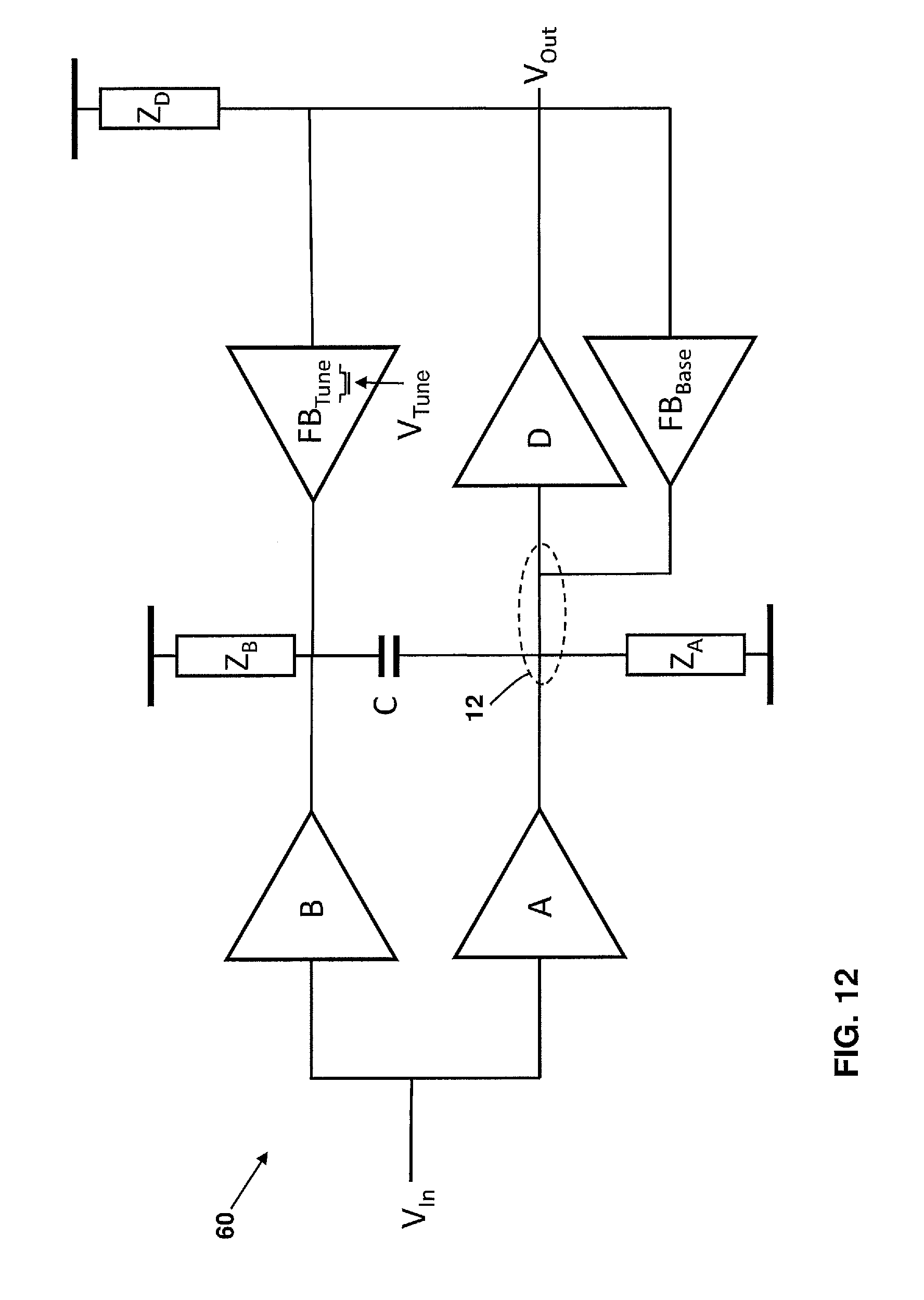
D00013
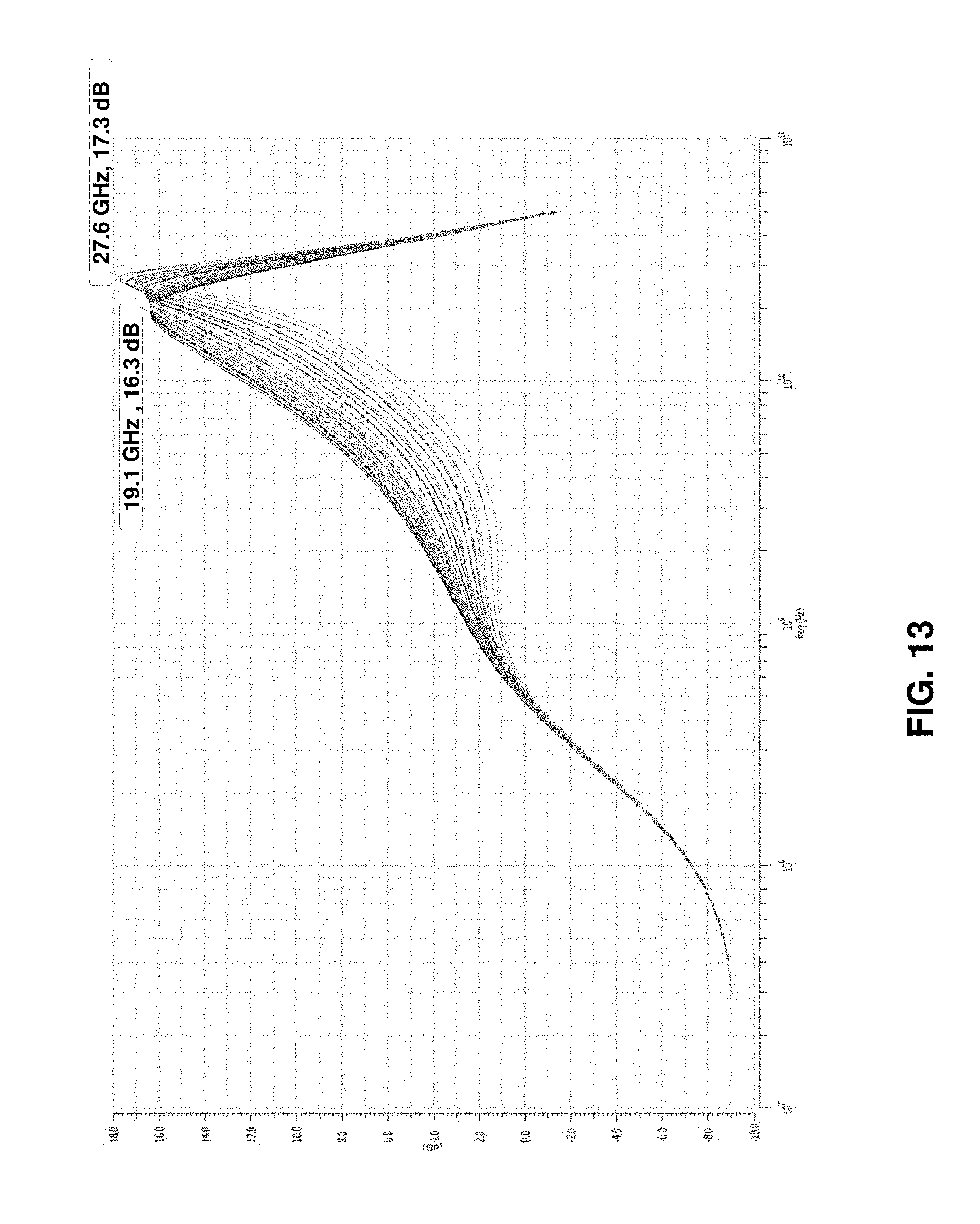
D00014
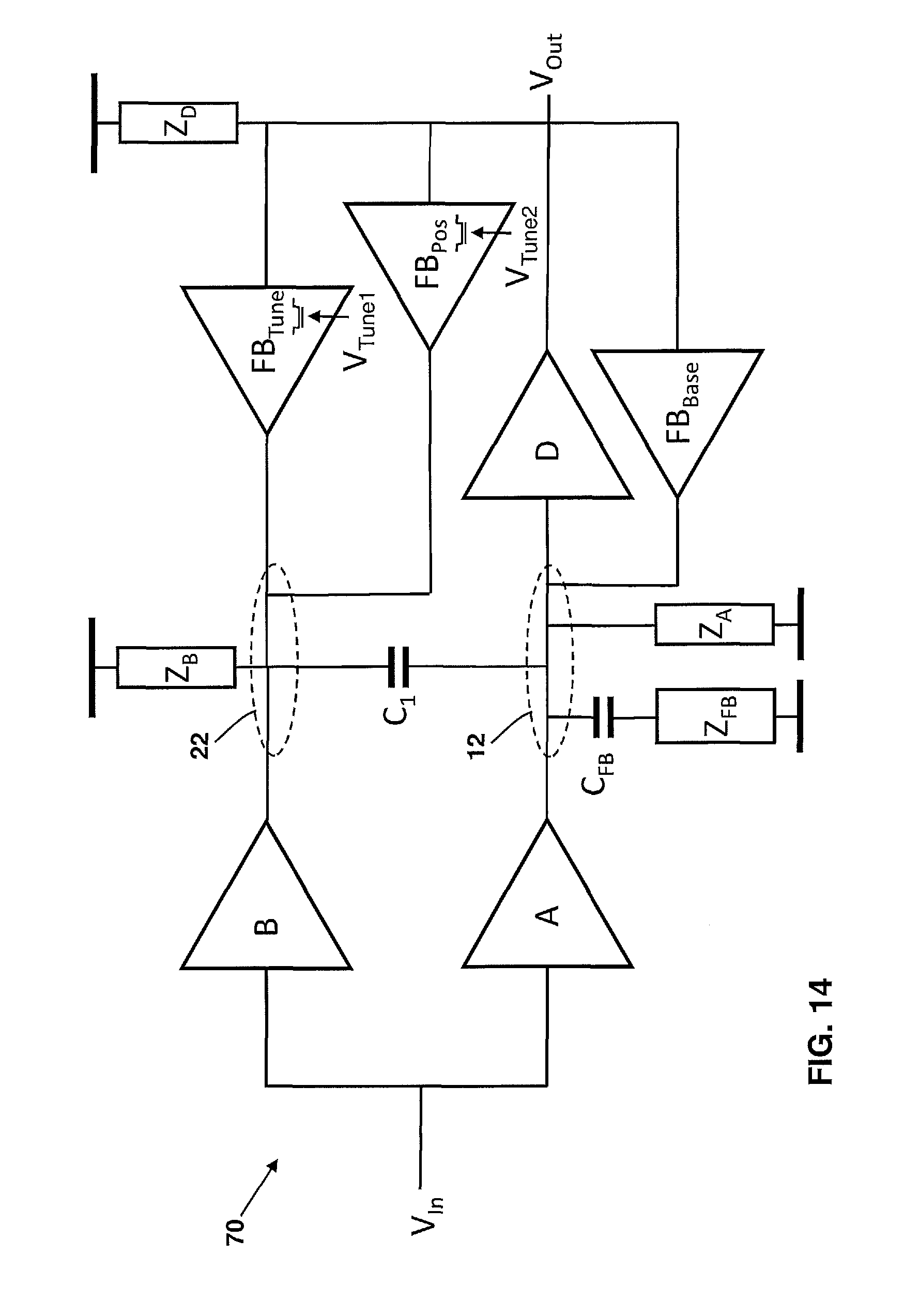
D00015
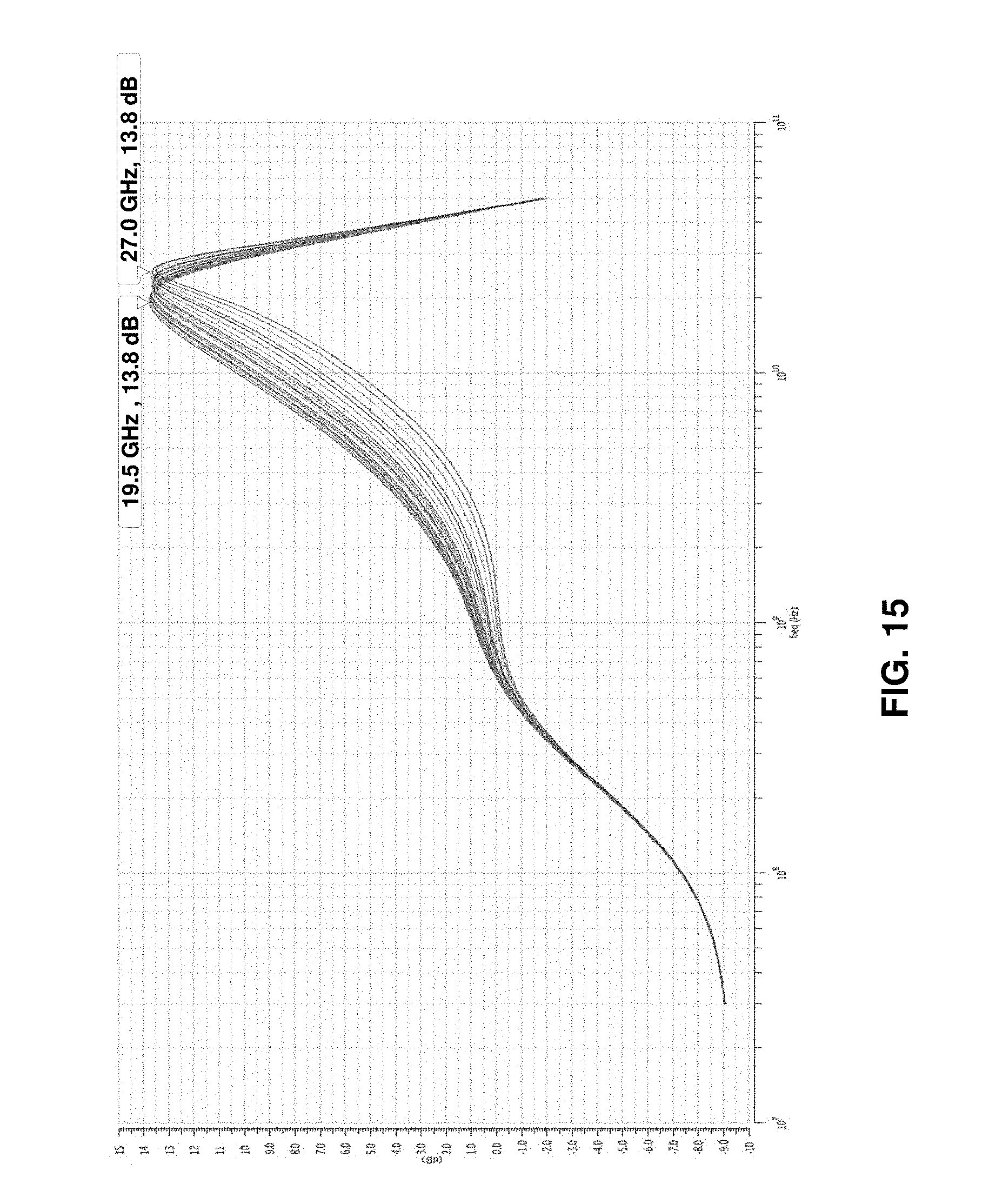
D00016

M00001

M00002

M00003

M00004

M00005

M00006

XML
uspto.report is an independent third-party trademark research tool that is not affiliated, endorsed, or sponsored by the United States Patent and Trademark Office (USPTO) or any other governmental organization. The information provided by uspto.report is based on publicly available data at the time of writing and is intended for informational purposes only.
While we strive to provide accurate and up-to-date information, we do not guarantee the accuracy, completeness, reliability, or suitability of the information displayed on this site. The use of this site is at your own risk. Any reliance you place on such information is therefore strictly at your own risk.
All official trademark data, including owner information, should be verified by visiting the official USPTO website at www.uspto.gov. This site is not intended to replace professional legal advice and should not be used as a substitute for consulting with a legal professional who is knowledgeable about trademark law.